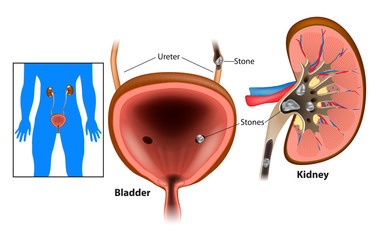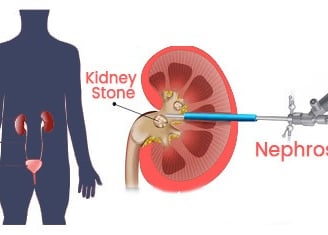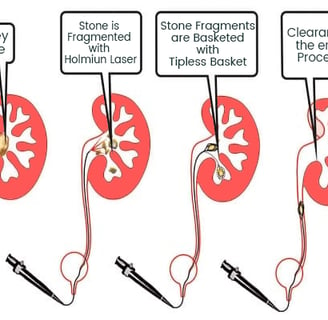Deciphering Kidney Stone Treatments
KIDNEY STONES


A Deep Dive into RIRS and PCNL Procedures
We in this article we'll unravel the complexities of modern medical interventions for kidney stones. Kidney stones, those formidable accumulations of minerals and salts, can present a painful challenge for many. As we explore the intricacies of Retrograde Intrarenal Surgery (RIRS) and Percutaneous Nephrolithotomy (PCNL), we recognize that each patient’s journey is unique. The choice of treatment is not one-size-fits-all; it is a decision shaped by the specific circumstances of each case. Factors such as the stone’s size, location, and composition, as well as the patient’s overall health, play a critical role in determining the most appropriate course of action.
We will delve into how these factors influence the decision-making process and why a personalized approach is essential. With expert insights and a clear understanding of RIRS and PCNL, patients can navigate their treatment options with confidence. The guidance of a skilled urologist is paramount, ensuring that each patient receives the treatment best suited to their individual needs, paving the way for a successful recovery and a stone-free future. Let’s embark on this informative journey together, shedding light on the path to relief and wellness.
Understanding Percutaneous Nephrolithotomy (PCNL)
PCNL: Percutaneous Nephrolithotomy (PCNL) is a surgical intervention aimed at removing large kidney stones situated in the kidney or the upper ureter. This procedure is particularly designated for stones that are too substantial to be naturally expelled through urination.
Indications for PCNL: PCNL is typically recommended when patients present with:
Stones exceeding 2 cm in diameter, though this threshold may vary.
Stones that pose a risk of severe complications or potential kidney damage.
Multiple obstructions within the kidney’s collecting system.
Stones that have migrated to the ureter.
Ineffectiveness of other stone removal treatments.
PCNL Surgical Process: The PCNL procedure involves:
A minor 1 cm incision in the flank area.
Placement of a tube into the kidney under X-ray guidance through the incision.
Insertion of a telescope for stone visualization and fragmentation.
Optional use of a laser to break down the stones for removal.
Advantages of PCNL:
Reduced postoperative pain.
Shorter convalescence period compared to other stone removal surgeries.
Limited hospital stay, typically ranging from 1 to 2 days, allowing patients to resume daily activities promptly.
Potential Risks Associated with PCNL: Bleeding, Infection, Damage to surrounding organs or tissues, Possibility of incomplete stone removal, Potential need for conversion to open surgery in certain cases.
PCNL stands out as a minimally invasive option with a high success rate for patients with large kidney stones, offering a quicker recovery and return to normalcy. It is a testament to the advancements in urological surgeries, providing a safer alternative to traditional open surgery.
Retrograde Intrarenal Surgery (RIRS): A Minimally Invasive Approach to Kidney Stones
RIRS: Retrograde Intrarenal Surgery (RIRS) is an endoscopic procedure designed to remove kidney stones by navigating through the ureter into the kidney. It employs a fiber optic endoscope and a holmium laser fiber to treat renal stones effectively.
Indications for RIRS: RIRS is typically recommended for patients with:
Kidney stones up to 2 cm in diameter, although size considerations may vary.
Non-opaque stones that are not visible on standard X-rays.
Bleeding disorders that contraindicate more invasive procedures.
Anatomical abnormalities such as a long lower pole calyx, acute infundibulopelvic angle (IPA), or narrow infundibulum.
Multiple kidney stones or nephrocalcinosis, a condition characterized by increased calcium levels in the kidneys.
RIRS Procedure: The RIRS technique involves:
Inserting a flexible ureterorenoscope into the bladder via the urethra, then advancing it to the kidney’s urine-collecting system.
Visualizing and fragmenting the kidney stone using an ultrasound or laser probe.
Optionally, removing the stone fragments manually with forceps.
Potentially placing a stent to facilitate drainage, based on the physician’s recommendation.
Removing smaller kidney stones with stone baskets after larger stones have been addressed.
The procedure is performed under general anesthesia and requires the expertise of a specialist urologist.
Risks Associated with RIRS: While RIRS is a minimally invasive and generally safe procedure, potential risks may include: Fever, Flank pain, Urinary infection, Transient hematuria (temporary presence of blood in urine), Abrasion of the ureteral pelvicalyceal system, Fornix rupture, Ureter avulsion (tearing away of the ureter), Bleeding, Sepsis (body’s response to infection), Trauma to the kidneys.
RIRS offers a less invasive alternative to traditional kidney stone removal methods, with a focus on patient safety and recovery. It is a testament to modern urological advancements, providing effective treatment with minimal postoperative discomfort and downtime.
Comparative Summary of RIRS and PCNL Treatments for Kidney Stones
Both Retrograde Intrarenal Surgery (RIRS) and Percutaneous Nephrolithotomy (PCNL) are effective treatments for kidney stones, each with specific indications based on the patient’s condition. RIRS, utilizing a holmium laser, serves as an alternative to PCNL for certain patients with large renal stones. The choice between RIRS and PCNL is determined by various factors, including the stone’s size, density, location, and the patient’s overall health.
Patients are encouraged to familiarize themselves with both procedures to make informed decisions in consultation with their healthcare providers. Early consultation with a doctor is crucial upon experiencing symptoms of kidney stones. Both RIRS and PCNL have proven to be highly effective in their respective capacities, significantly reducing the likelihood of stone recurrence when conducted by skilled urologists.




